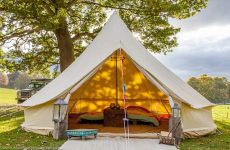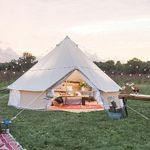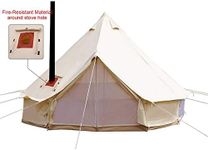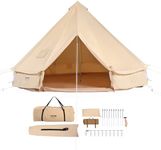Buying Guide for the Best Bell Camping Tents
Choosing the right bell camping tent can significantly enhance your outdoor experience. Bell tents are known for their spacious interiors and classic design, making them a popular choice for campers who value comfort and style. When selecting a bell tent, it's important to consider several key specifications to ensure it meets your needs. Here are the main factors to consider and how to navigate them.SizeThe size of a bell tent is crucial as it determines how many people can comfortably sleep inside and how much gear you can store. Sizes are usually measured in diameter, ranging from small (3-4 meters) to large (5-6 meters or more). A smaller tent is easier to set up and transport, making it ideal for solo campers or couples. Larger tents provide more space for families or groups and can accommodate additional furniture like camping beds and tables. Consider the number of occupants and the amount of gear you plan to bring when choosing the size.
MaterialBell tents are typically made from canvas or polyester. Canvas tents are durable, breathable, and offer excellent insulation, making them suitable for various weather conditions. However, they are heavier and require more maintenance. Polyester tents are lighter, more affordable, and easier to clean, but they may not provide the same level of comfort in extreme weather. If you plan to camp in diverse climates and prioritize durability, a canvas tent is a good choice. For occasional camping in mild conditions, a polyester tent may suffice.
WaterproofingWaterproofing is essential to keep you dry during rainy weather. Look for tents with a high hydrostatic head rating, which indicates the level of water resistance. A rating of 1500mm to 3000mm is generally sufficient for most camping trips. Additionally, check for features like taped seams and waterproof zippers, which enhance the tent's ability to keep water out. If you expect to camp in wet conditions, prioritize tents with higher waterproof ratings and additional waterproofing features.
VentilationGood ventilation is important to prevent condensation and maintain a comfortable temperature inside the tent. Look for tents with multiple windows, mesh panels, and roof vents. These features allow for better airflow and help reduce moisture buildup. If you plan to camp in warm or humid environments, prioritize tents with ample ventilation options to ensure a pleasant camping experience.
Ease of SetupThe ease of setup can greatly affect your camping experience, especially if you need to pitch the tent quickly. Bell tents typically have a central pole and guy lines, making them relatively straightforward to set up. However, larger tents may require more time and effort. Consider your experience level and whether you will have assistance when setting up the tent. If you prefer a quick and easy setup, look for tents with simple designs and fewer components.
WeightThe weight of the tent is an important consideration, especially if you need to carry it over long distances. Canvas tents are heavier but offer better durability and insulation, while polyester tents are lighter and easier to transport. If you plan to hike to your campsite or move frequently, a lighter tent may be more practical. For car camping or stationary setups, weight may be less of a concern, allowing you to opt for a more robust tent.
Additional FeaturesAdditional features can enhance your camping experience and provide extra convenience. Look for features like built-in groundsheets, interior pockets, and awnings. Built-in groundsheets help keep the interior clean and dry, while interior pockets provide storage for small items. Awnings offer extra shade and protection from the elements. Consider which features are important to you based on your camping style and preferences.










